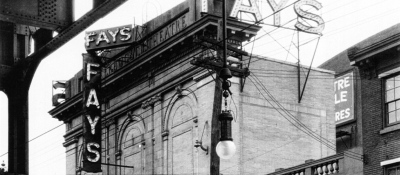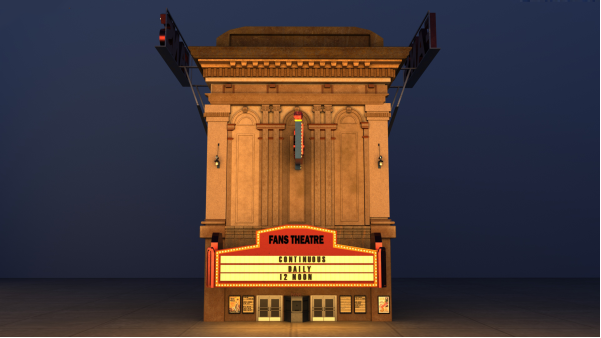Drexel Theatre and Digital Media Tell the Story of Philadelphia’s Black Bottom Neighborhood
March 13, 2023
Today, the neighborhood West of Philadelphia’s Schuylkill River and home to the campuses of Drexel University and the University of Pennsylvania, is known as University City. From the turn of the 20th century until the 1960s, however, the area was home to a close-knit community known as Black Bottom. The predominantly Black neighborhood was largely razed between the 50s and 70s in a redevelopment project organized by Penn, Drexel, Presbyterian Hospital, and other institutions, collectively known as the West Philadelphia Corporation. Unified by a goal to create “elbow room and a more healthful campus environment,” the West Philadelphia Corporation’s project ultimately displaced roughly 5,000 residents from the neighborhood. (Source: Temple Libraries)
Though Philadelphia is a city that wears its history on its sleeve, with a thriving tourism industry around the landmarks of early American democracy, many significant histories of the more recent past – like the leveling of Black Bottom – remain untold. Today, however, two different projects in the Antoinette Westphal College of Media Arts & Design engage with University City’s history of gentrification.
Celebrating Black Bottom as a Living History Onstage

Resilient Production photo by Josiah Randleman
“We decided to make this piece about the experience of learning the history of your school and the system that’s part of this displacement,” says Brett Ashley Robinson, director of Drexel Theatre’s recent production, Resilient: The Black Bottom Project. Produced in collaboration with local theatre artists, Resilient was a work of devised performance that ran for two weekends in Drexel’s Black Box Theater.
When setting about creating a play inspired by the history of Black Bottom and gentrification in University City, Robinson realized quickly that the students involved in the production didn’t know much about that history. In collaboration with creator Carlo Campbell and dramaturg Adrena Williams, Robinson worked that learning process into the heart of the production. The play incorporated the students’ reactions and experience when confronted with the history of their home institution, while also encouraging them – and audiences – to move beyond guilt and complicity into actionable steps.
It was critical for the company to build empathy within the stories of Black Bottom, even though most have vastly different lived experience. Having come through the pandemic during their formative years, many connected with the sense of grief for a stolen future, drastically altered lives, and loss of control.
The student creators and performers of the piece came from diverse majors across Drexel University, from Screenwriting & Playwriting to business, hospitality management, and computer science. That spirit of transdisciplinary collaboration brought strengths; students had different ways of processing and translating information.
“They’re so bright and intelligent and fearless about artmaking,” Robinson says about working with Drexel students. “It’s astonishing how empowered these students became to take accountability, and to envision a way to transform the world that starts with them.” Resilient aimed to inspire celebration of Black Bottom and personal investment in one’s own community.
Each showing was paired with a second-act discussion with a resident of Black Bottom, including Penn professor, civil rights activist, and community organizer Dr. Walter Palmer, during which audiences were encouraged to engage with the living history of the neighborhood. Former Black Bottom resident Andre Black passed photos around the audience, telling stories that reflect a community of close neighbors who looked out for one another.
With the city of Philadelphia evolving so rapidly around its citizens, Resilient created a space to pause, place value on the real people of a community, and bring a microphone to an untold history.
Commemorating an Historic Community in Digital Space
In his research, Digital Media associate professor Glen Muschio is driven by questions of historiography: who decides what stories are told? How can new and emerging technologies bring invisible histories to life? As part of Drexel University’s STAR Scholars Program (Students Tackling Advanced Research), two undergraduate students under Muschio’s mentorship applied such questions to the history of Black Bottom.
Annie Dao (Animation & Visual Effects ’26) and Jillian Wright (Digital Media & Virtual Production ’26) participated in STAR Scholars during the summer of 2022 and contributed research to the Black Bottom project. The focus of this ongoing research project is to commemorate the Black Bottom community and promote social justice through the production of a self-guided augmented reality (AR) walking tour of the neighborhood.
Dao and Wright conducted interviews of Black Bottom residents, including Walter Palmer and Black Bottom Tribe member Sid Bolling. They conducted research in the City of Philadelphia Archives and met with representatives from the University City Science Center. Intrigued by the archival research and Palmer’s extensive knowledge of the Black Bottom music and jazz community, Dao chose to focus her efforts on producing a 3D model of Fans Theater, a significant cultural landmark in Black Bottom.
 Fans Theatre (1944-1963), origilally known as Fay’s Theatre (1931-1944), were among the earliest Black-owned jazz venues and movie theaters in West Philly. Located along 40th and Market Streets, Fans was a 2,500-seat venue for Vaudeville acts and featured local Black artists, bands, and iconic jazz musicians like Duke Ellington and Louis Armstrong. Along with live entertainment, Fans was a cinema that showed second run movies, cartoons, and news reels. In addition, Fans helped ease poverty and crime as it opened its doors for church service, offered free meals for the disadvantaged, and served as a youth center during Christmas. In 1964, the roof of Fans Theatre collapsed, and the building was demolished.
Fans Theatre (1944-1963), origilally known as Fay’s Theatre (1931-1944), were among the earliest Black-owned jazz venues and movie theaters in West Philly. Located along 40th and Market Streets, Fans was a 2,500-seat venue for Vaudeville acts and featured local Black artists, bands, and iconic jazz musicians like Duke Ellington and Louis Armstrong. Along with live entertainment, Fans was a cinema that showed second run movies, cartoons, and news reels. In addition, Fans helped ease poverty and crime as it opened its doors for church service, offered free meals for the disadvantaged, and served as a youth center during Christmas. In 1964, the roof of Fans Theatre collapsed, and the building was demolished.
Dao produced a 3D model version of Fans Theatre in Autodesk Maya, adding texture through Adobe Substance Painter. There were only few archival photos to work from, making it necessary to conduct further research into building permits and microfilm. In future iterations, Dao expects more versions of Fans to be modeled, along with production of 3D models for other relevant landmarks to augment the tour. The project has the support of the Science Center in its continuation.

3D model of Fans Theatre, created by Annie Dao
Wright, meanwhile, was drawn to a Black Bottom landmark familiar to most in the Drexel community. The 33rd Street Armory is still standing, and today it is primarily used as an event venue. Through consultations with Dr. Palmer, Wright learned that the Armory played an important role in the community, serving as a hub for food distribution to those in need. Though it has a place on the National Register of Historic Places, Wright met challenges in finding historic photos that conveyed how it appeared in the early 20th century. There was only one archival photo available, but Wright made a significant breakthrough by obtaining blueprints through Drexel’s Real Estate & Facilities Office. The blueprints created a solid foundation for Wright’s 3D model of the Armory; with the bones of the building complete, next steps include digital completion of the intricate façade and application of textures to the model for inclusion in the AR tour.

3D model of the 33rd Street Armory, by Jillian Wright
These efforts within Westphal to bring awareness to Black Bottom’s story come at a uniquely relevant time. At this moment, a resident-led coalition is organizing to save the University City Townhomes, a 70-unit low-income housing project at 40th and Market Streets, within the borders of the historic Black Bottom. Residents now face eviction and displacement following the announcement that the Townhomes’ HUD contract would not be renewed.
The Black Bottom AR Project is only in its infancy, and Muschio envisions it as a three to five-year process. Meanwhile, Muschio received a Summer Research Award from Drexel’s Office of Faculty Advancement to support another digital heritage project, the production of two digital 3D models for the development of a virtual storytelling space encouraging critical examination of ideas about art and science in the context of class, race and religious beliefs and practices that informed C.W. Peale’s celebrated Philadelphia Museum of Art and Science. The Peale Museum Project aims to shed light on the efforts of Moses Williams, who worked in the Museum while enslaved and, following manumission, became the silhouette portrait concessioner in the Long Room Gallery. Williams’s contributions have been largely unrecognized in historical records, but the project can bring new attention to the untold story via new technologies.
“While the Black Bottom Project has only just started, it is truly an honor to help bring awareness and keep the legacy of the Black Bottom alive,” says Dao.
“This project is important because it will raise awareness about what urban renewal does to a community,” Wright says in her project conclusions. “While this type of community destruction should never happen again, it's happening right now.”

Learn more about Philadelphia’s Black Bottom here.